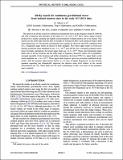Por favor, use este identificador para citar o enlazar a este item:
http://hdl.handle.net/10261/262765COMPARTIR / EXPORTAR:
 SHARE SHARE
 CORE
BASE CORE
BASE
|
|
| Visualizar otros formatos: MARC | Dublin Core | RDF | ORE | MODS | METS | DIDL | DATACITE | |

| Título: | All-sky search for continuous gravitational waves from isolated neutron stars in the early O3 LIGO data |
Autor: | Abbott, R.; Barneo, P.; Guixé, G.; Colleoni, Marta; Covas, P.B.; Estellés, Héctor; García-Quirós, Cecilio; Husa, Sascha; Jaume, Rafel; Keitel, David; Mateu-Lucena, Maite; Zweizig, John G.; LIGO Scientific Collaboration; Virgo Collaboration; KAGRA Collaboration | Palabras clave: | Astrophysical studies of gravity Gravitational wave detection Gravitational wave sources Gravitational waves |
Fecha de publicación: | 8-oct-2021 | Editor: | American Physical Society | Citación: | Physical Review - Section D - Particles and Fields 104: 082004 (2021) | Resumen: | We report on an all-sky search for continuous gravitational waves in the frequency band 20-2000 Hz and with a frequency time derivative in the range of [-1.0,+0.1]×10-8 Hz/s. Such a signal could be produced by a nearby, spinning and slightly nonaxisymmetric isolated neutron star in our Galaxy. This search uses the LIGO data from the first six months of Advanced LIGO's and Advanced Virgo's third observational run, O3. No periodic gravitational wave signals are observed, and 95% confidence-level (C.L.) frequentist upper limits are placed on their strengths. The lowest upper limits on worst-case (linearly polarized) strain amplitude h0 are ∼1.7×10-25 near 200 Hz. For a circularly polarized source (most favorable orientation), the lowest upper limits are ∼6.3×10-26. These strict frequentist upper limits refer to all sky locations and the entire range of frequency derivative values. For a population-averaged ensemble of sky locations and stellar orientations, the lowest 95% C.L. upper limits on the strain amplitude are ∼1.4×10-25. These upper limits improve upon our previously published all-sky results, with the greatest improvement (factor of ∼2) seen at higher frequencies, in part because quantum squeezing has dramatically improved the detector noise level relative to the second observational run, O2. These limits are the most constraining to date over most of the parameter space searched. | Descripción: | Abbott, R. (LIGO Scientific Collaboration, Virgo Collaboration, KAGRA Collaboration) | Versión del editor: | http://doi.org/10.1103/PhysRevD.104.082004 | URI: | http://hdl.handle.net/10261/262765 | DOI: | 10.1103/PhysRevD.104.082004 | Identificadores: | doi: 10.1103/PhysRevD.104.082004 issn: 2470-0029 |
| Aparece en las colecciones: | (ICE) Artículos |
Ficheros en este ítem:
| Fichero | Descripción | Tamaño | Formato | |
|---|---|---|---|---|
| All-sky_search_early_03_LIGO_data.pdf | 2,47 MB | Adobe PDF |  Visualizar/Abrir |
CORE Recommender
SCOPUSTM
Citations
35
checked on 04-may-2024
WEB OF SCIENCETM
Citations
36
checked on 28-feb-2024
Page view(s)
29
checked on 07-may-2024
Download(s)
22
checked on 07-may-2024
Google ScholarTM
Check
Altmetric
Altmetric
NOTA: Los ítems de Digital.CSIC están protegidos por copyright, con todos los derechos reservados, a menos que se indique lo contrario.
